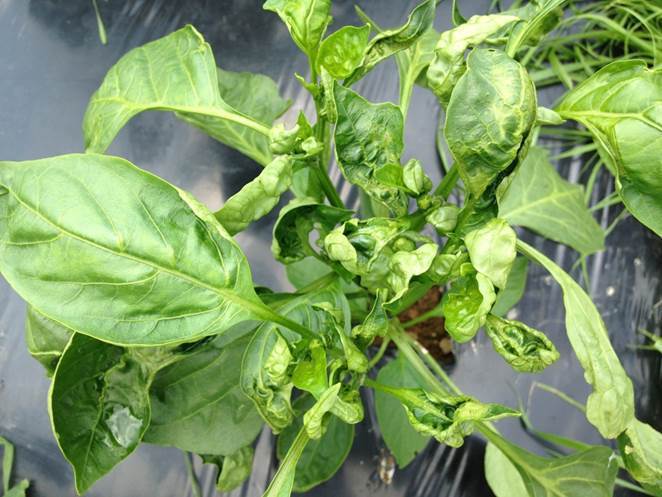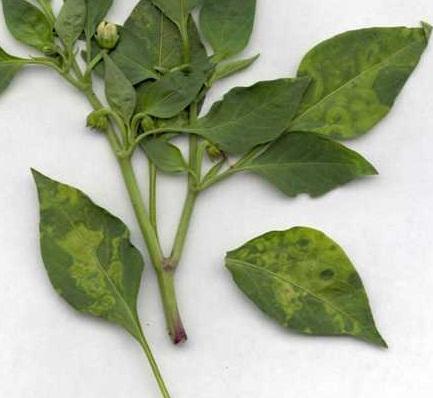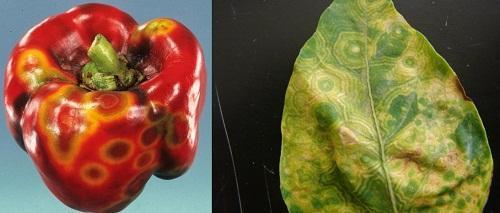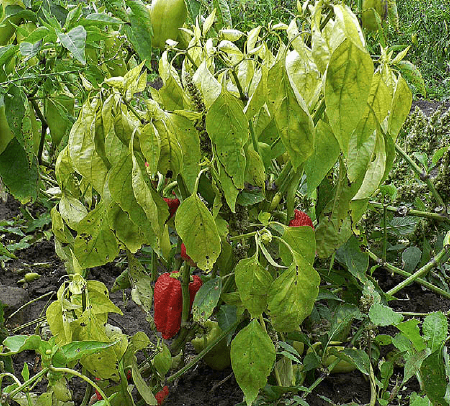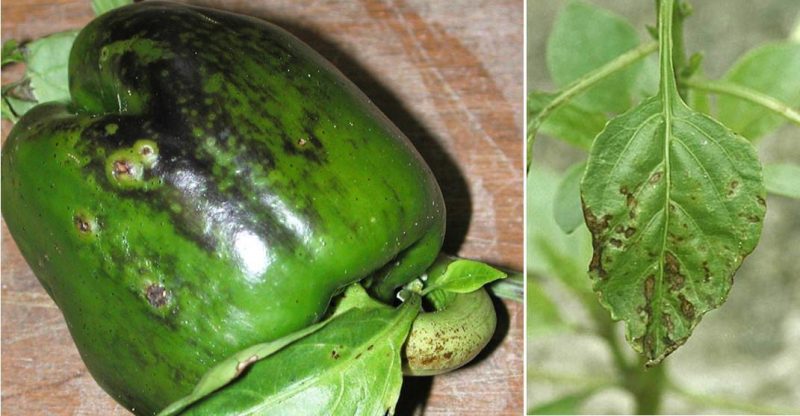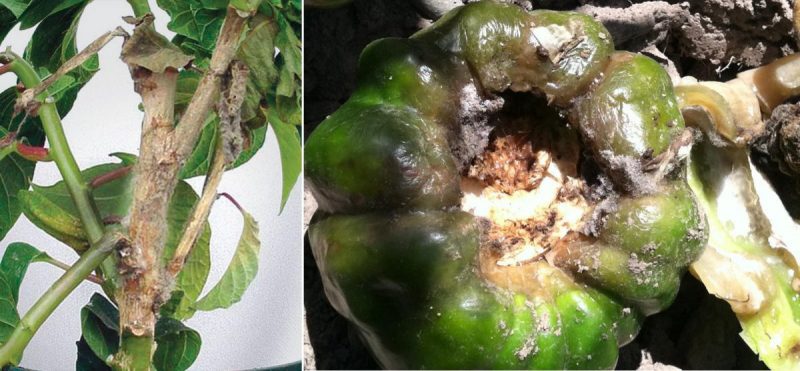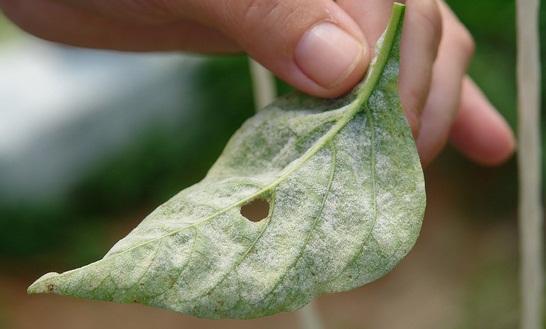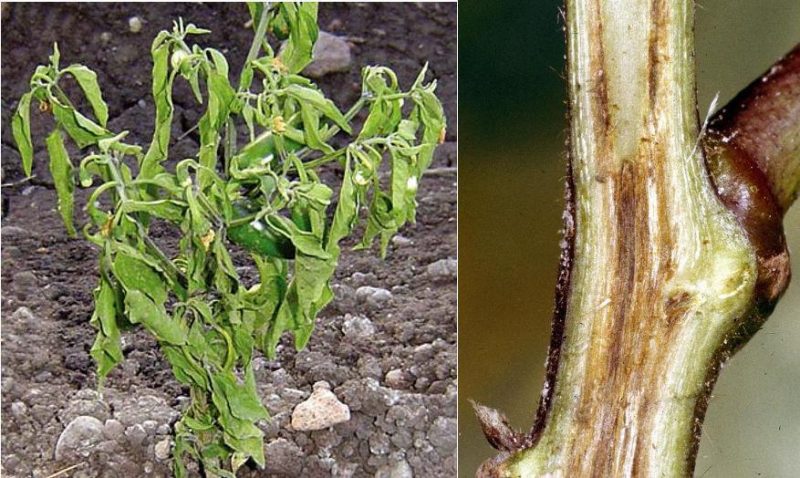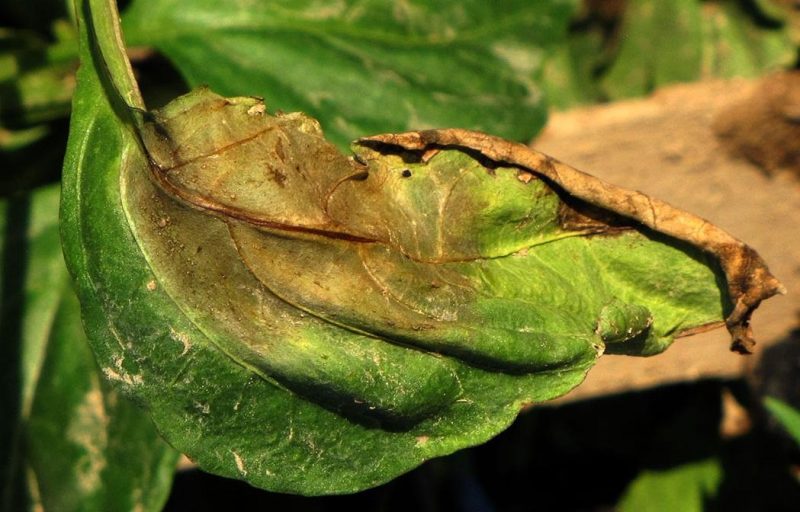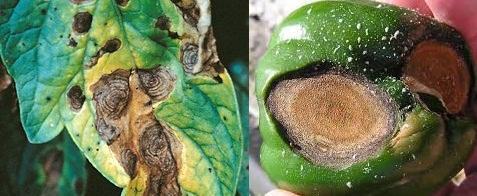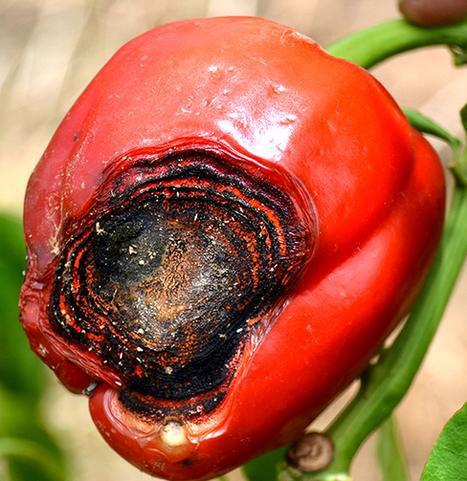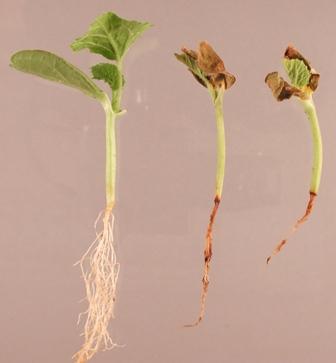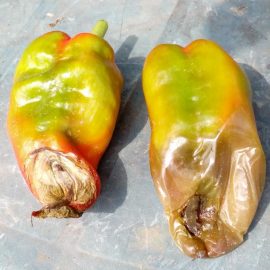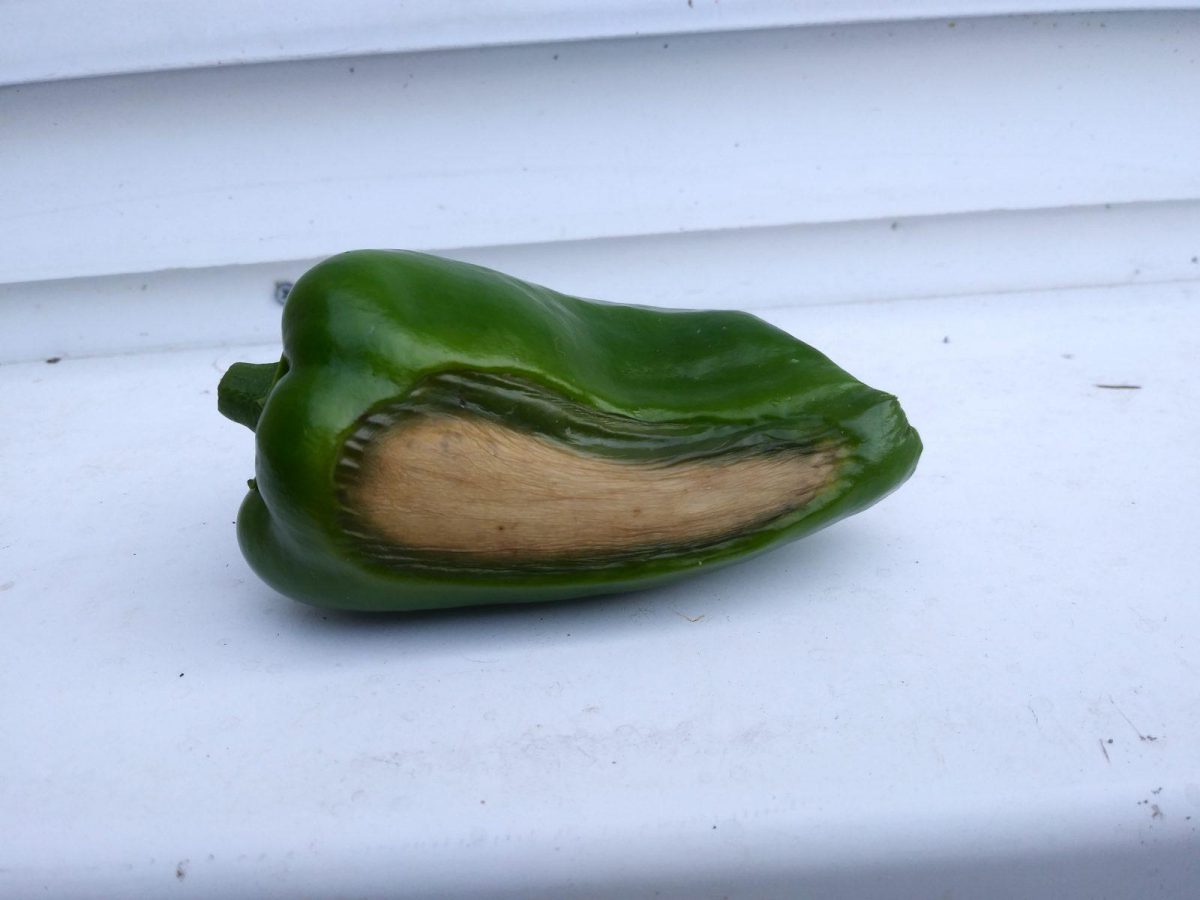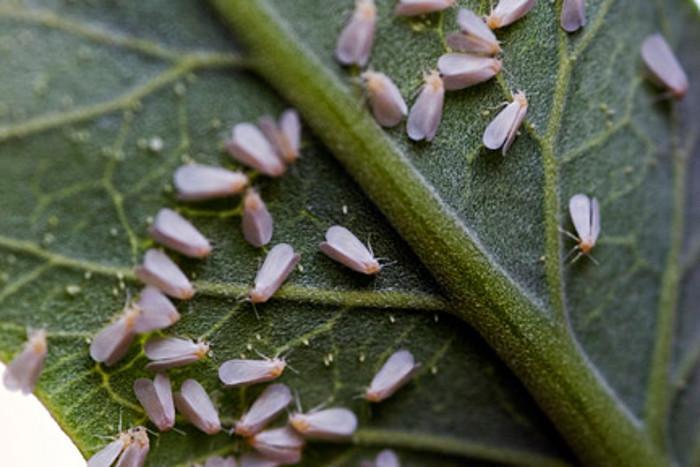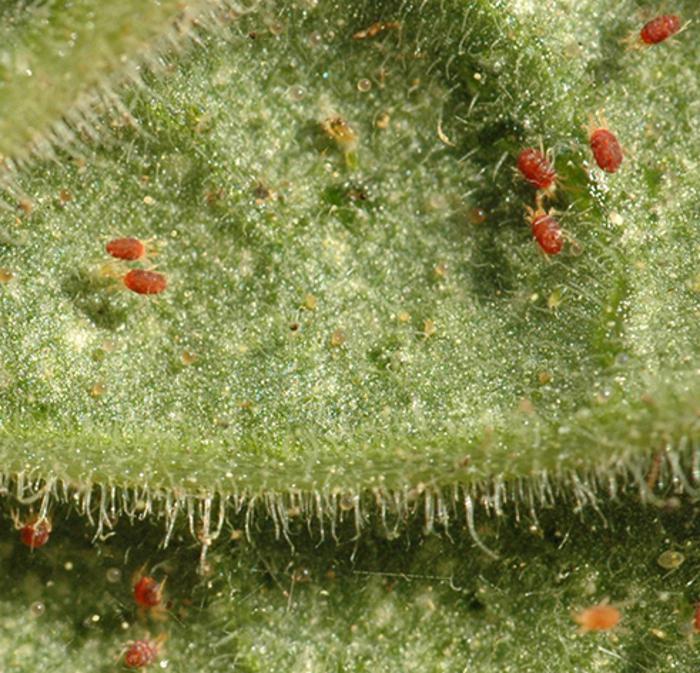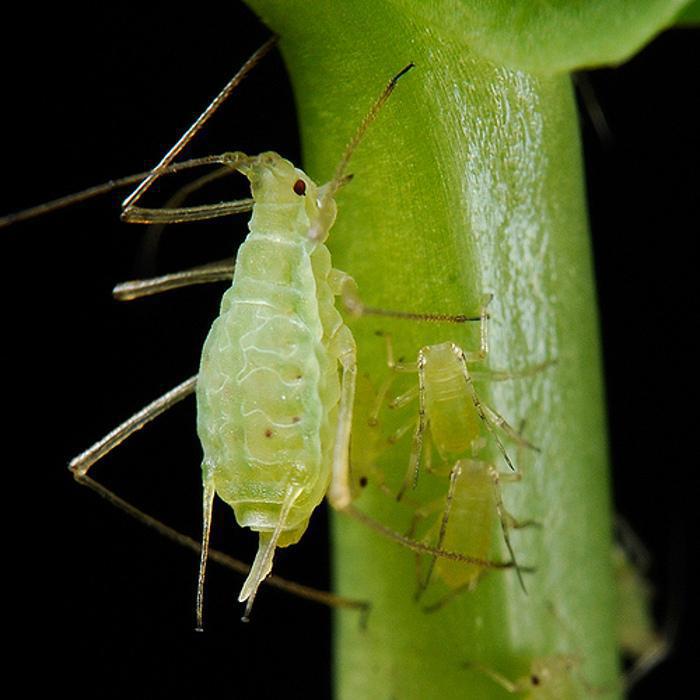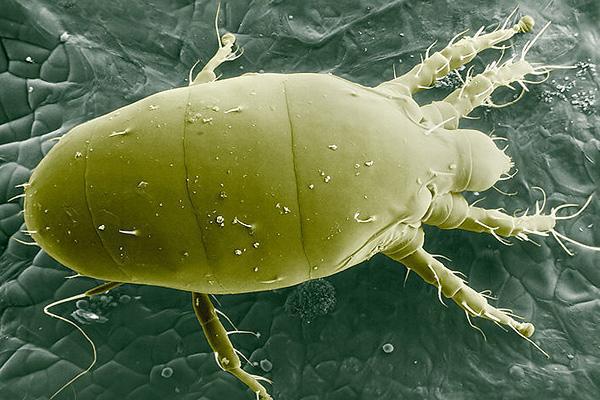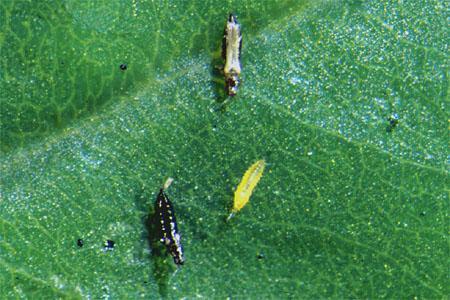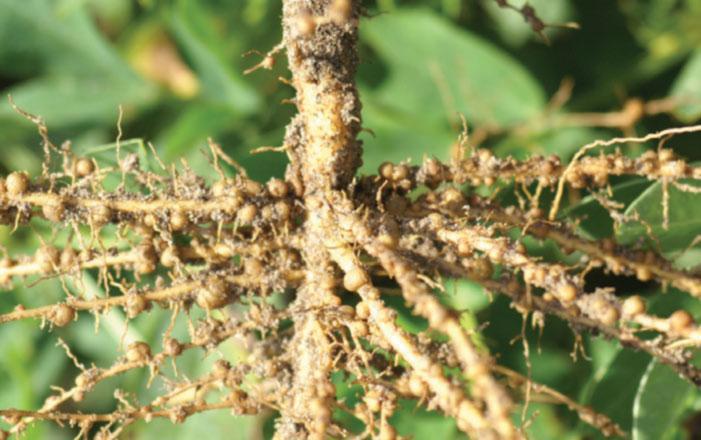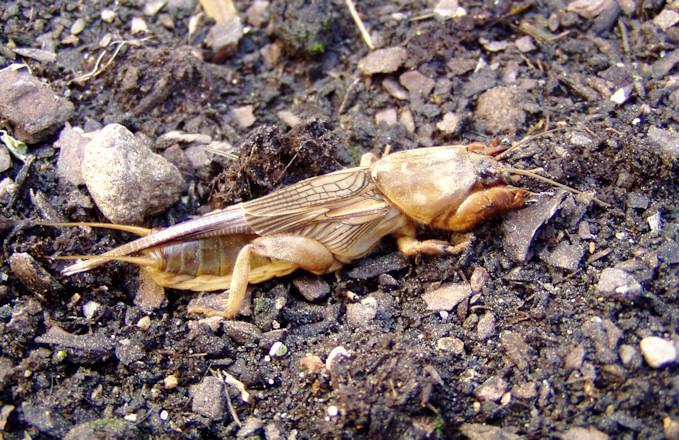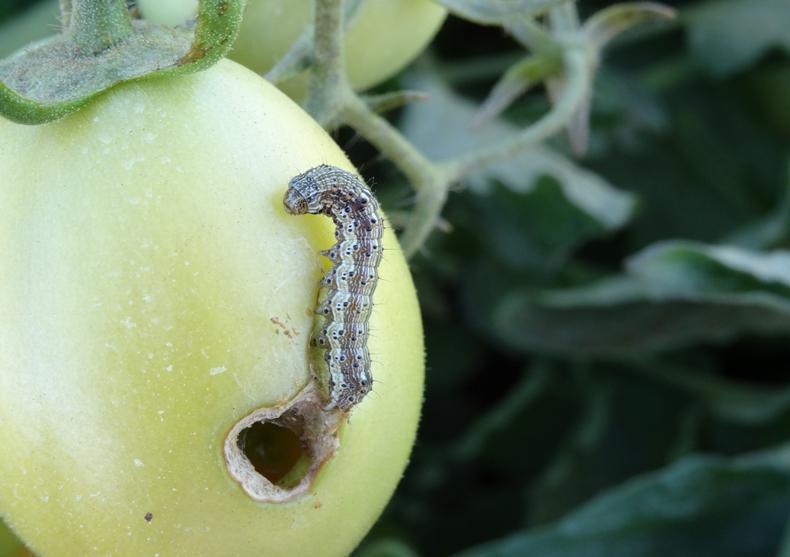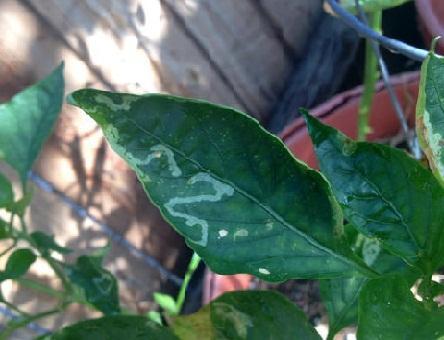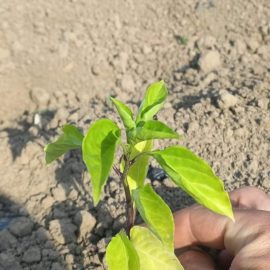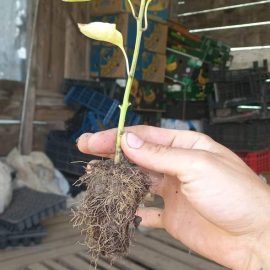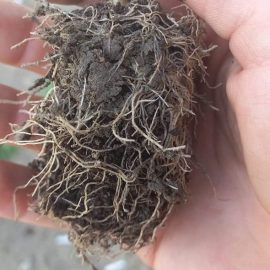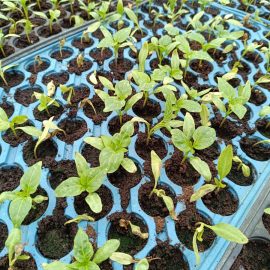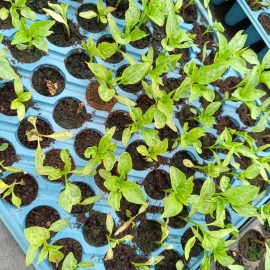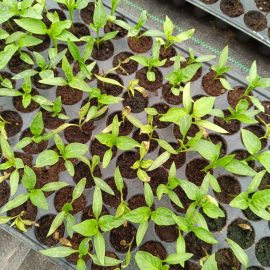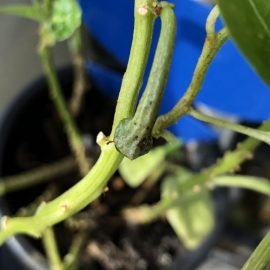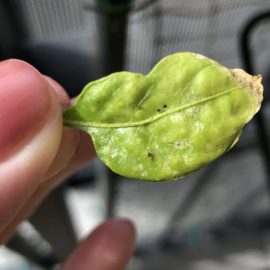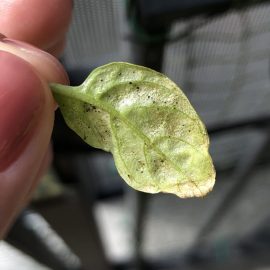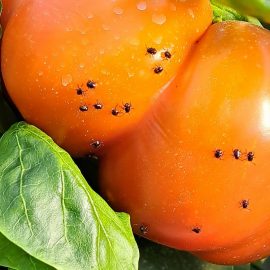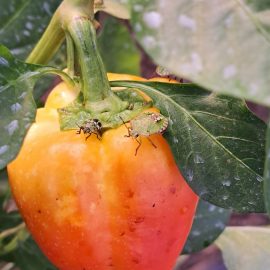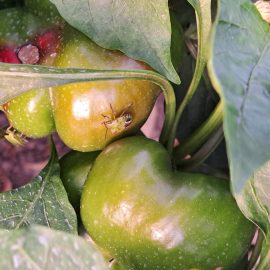Pepper, treatments against pests and diseases
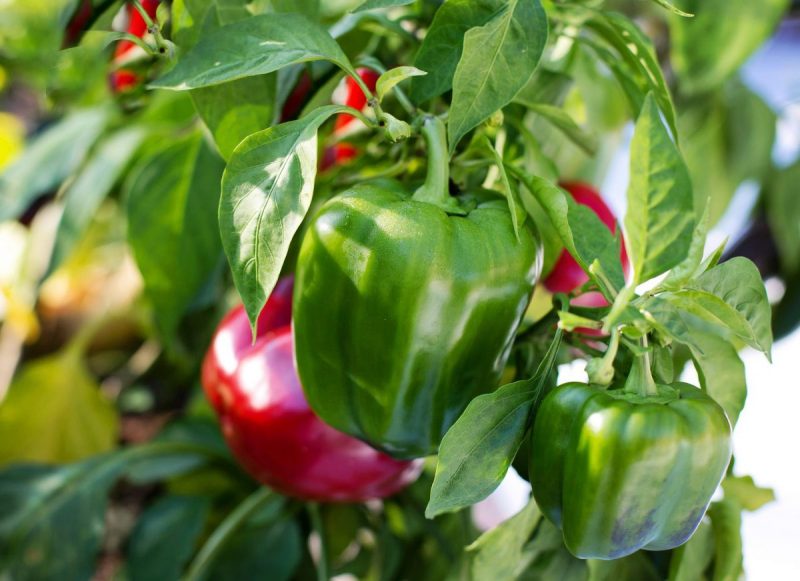
Pepper (Capsicum annuum) is a plant that occupies an important place among vegetable crops. The pepper is native to America, Mexico, and Guatemala, and from here it has spread to the north, to the USA, and to the south, to Colombia, Venezuela, Equator, Brazil, etc. Peppers are a demanding plant regarding growing factors and grow well if the right cultivation technology is used. The pepper can be affected by pests and diseases, against which it’s important to apply the right treatments.
The main diseases of peppers
VIRUSES
Cucumber mosaic virus in pepper
Damaged young plants are much shorter, up to 50% of the height of healthy plants. The plant’s internodes and branches are short, resulting in a clustered (dense) appearance. The leaves are small, with a deformed leaf blade and a mosaic appearance (alternating healthy green tissue with dark green or yellow tissue). Grey or brown spots can sometimes be observed on the attacked stems. Attacked fruits are small and deformed. The virus has a wide host circle, both annual and perennial species, which are sources of infection. Examples of hosts: Shepherd’s purse, Chickweed, Purple dead nettle, etc. The virus is transmitted by several species of aphids.
Prevention and control measures:
- the seedlings shall be produced in areas where no other solanaceous crops (tomatoes, aubergines, etc.) are grown;
- the host plants (weeds) in the crop and around the plot must be destroyed;
- pepper culture should be isolated from other solanaceous crops (tomatoes, eggplant, potatoes, etc.);
- regular insecticide treatments to control insect pests;
- remove attacked plants from the crop;
- grow resistant varieties.
Tobacco mosaic virus in pepper
Symptoms vary depending on the plant variety. In general, yellow spots appear on the leaves, and they take on a mosaic appearance. Fruits are deformed, small, with circular or irregular chlorotic spots, and green, yellowish, or brown. The disease is transmitted by direct contact between healthy and diseased plants, by agricultural tools or machinery, and by infected seed and soil.
Prevention and control measures:
- seed treatment before sowing and disinfecting the substrate in the seedbed;
- growing resistant varieties;
- pepper crops should not follow tomatoes, aubergines, peppers or potatoes.
Tomato spotted wilt virus in pepper
The disease manifests itself as a mosaic-like patch on the growing tips of plants. The disease later progresses and circular brown, yellow, or dark green spots appear on the aerial parts, leading to necrotic tissue. Attacked plants are smaller than healthy ones and produce a small amount of fruit. The virus has a wide host circle of annual and perennial species, which are sources of infection all year round. The disease is transmitted mainly by thrips.
Prevention and control measures:
- removing attacked plants from the crop;
- destroying host plants (weeds) in the crop and around the plot;
- isolating the pepper crop from other solanaceous crops (tomatoes, aubergines, potatoes, etc.);
- periodic insecticide treatments to control insect pests;
- growing resistant pepper varieties.
MYCOPLASMA
Stolbur disease in pepper
The disease is common to all plants in the Solanaceae family (tomatoes, peppers, potatoes, eggplants) and is caused by mycoplasma. This disease is present in most European countries, but the greatest damage is reported in the eastern part of the continent. Symptoms of discoloration appear on the leaves, plant growth stagnates, and flowers remain sterile or form small and deformed fruits. In severe cases, the disease causes verticillium-like wilting, but in this case, the conducting vessels are not browned. The source of infection is represented by host plants (field bindweed, dodder, orache) or diseased plants (tomatoes, peppers, eggplants, potatoes) and is transmitted to healthy plants by several species of cicadas (insects).
Prevention and control measures:
- destroying the host plants and the dodder;
- controlling insects that transmit Mycoplasma;
- removing attacked plants from the crop;
- growing resistant varieties.
BACTERIOSIS
Bacterial leaf spot (Xanthomonas campestris)
This bacteriosis also attacks tomato crops very often. In a mild attack, the bacterium causes necrotic spots on the leaves, and in a severe attack, it can cause necrotic spots on all the aerial organs of the plant. In susceptible varieties, the spots multiply, merge, and cause plant defoliation. On the stems, the disease produces elongated cracks, which turn brown. Affected fruits show circular, moist-looking, brown, and rough spots. Symptoms are noticeable in wet weather when bacterial ooze is visible on the wounds. Exudate left in the soil and on plant debris allows the bacterium to spread.
Prevention and control measures:
- using healthy seeds from safe sources;
- growing resistant varieties;
- pepper crops should not be grown on soils where tomatoes, aubergines, peppers, or potatoes have been planted;
- pepper treatments with copper-based fungicides.
MYCOSIS
Gray mold (Botrytis cinerea)
The attack occurs in greenhouses and polytunnels, and even in the field in years with heavy rainfall. The most common symptom is sudden wilting of succulent tissues, such as young stems and leaves. On the fruit, the attack manifests itself as brown, moist spots, and in high humidity, a greyish fuzz develops on the spot’s surface.
Prevention and control measures:
- chemical or thermal soil disinfection;
- rational fertilization;
- avoiding sprinkler irrigation,
- pepper treatments with specific fungicides.
Recommended products
-
You can find products on a different store
Change Store -
You can find products on a different store
Change Store -
You can find products on a different store
Change Store -
You can find products on a different store
Change Store -
You can find products on a different store
Change Store -
You can find products on a different store
Change Store -
You can find products on a different store
Change Store -
You can find products on a different store
Change Store -
You can find products on a different store
Change Store -
You can find products on a different store
Change Store -
You can find products on a different store
Change Store -
You can find products on a different store
Change Store -
You can find products on a different store
Change Store -
You can find products on a different store
Change Store -
You can find products on a different store
Change Store -
You can find products on a different store
Change Store -
You can find products on a different store
Change Store -
You can find products on a different store
Change Store -
You can find products on a different store
Change Store -
You can find products on a different store
Change Store -
You can find products on a different store
Change Store -
You can find products on a different store
Change Store -
You can find products on a different store
Change Store -
You can find products on a different store
Change Store
Powdery mildew (Leveillula taurica)
The pathogen attacks plants in greenhouses, polytunnels, and fields. Yellow spots appear on the leaves, which will be covered with white fuzz. The disease develops and the fuzz covers the entire leaf and becomes dusty. The attacked tissues dry out, and in severe cases, the disease can lead to plant defoliation. The disease can spread to young fruit and leaf petiole. The fungus overwinters in the soil, and during vegetation, the disease is transmitted by the pathogen’s spores, which are carried by wind, water droplets, or other vectors (animals, people, tools).
Prevention and control measures:
- growing varieties and hybrids with genetic resistance;
- collecting and burning plant debris;
- removing diseased plants from the crop;
- deep autumn plowing;
- rational crop rotation (peppers shouldn’t be grown after tomatoes, potatoes, eggplants, etc.);
- pepper treatments with specific fungicides.
Recommended products
-
You can find products on a different store
Change Store -
You can find products on a different store
Change Store -
You can find products on a different store
Change Store -
You can find products on a different store
Change Store -
You can find products on a different store
Change Store -
You can find products on a different store
Change Store -
You can find products on a different store
Change Store -
You can find products on a different store
Change Store -
You can find products on a different store
Change Store -
You can find products on a different store
Change Store -
You can find products on a different store
Change Store -
You can find products on a different store
Change Store -
You can find products on a different store
Change Store -
You can find products on a different store
Change Store -
You can find products on a different store
Change Store -
You can find products on a different store
Change Store -
You can find products on a different store
Change Store -
You can find products on a different store
Change Store -
You can find products on a different store
Change Store -
You can find products on a different store
Change Store -
You can find products on a different store
Change Store -
You can find products on a different store
Change Store -
You can find products on a different store
Change Store -
You can find products on a different store
Change Store
Fusarium wilt (Fusarium oxysporum)
The disease is favored by temperatures above 27-28 ºC, high soil moisture, and slightly acidic pH. Affected plants show leaf discoloration followed by wilting. At first, the plants suffer from temporary wilting, but in the end, the process is irreversible. Fusarium wilt is a vascular disease and sections of the stems reveal intense browning of the conducting vessels. The fungus lives in the soil, being spread by water or by agricultural tools and equipment. It penetrates the plant through the root system, and under favourable conditions can lead to wilting within two weeks. The fungus also spreads through infected seeds.
Prevention and control measures:
- chemical or thermal soil disinfection in greenhouses, polytunnels, and hotbeds;
- avoiding relative humidity above 85% in greenhouses and polytunnels and avoiding water-stagnant soils;
- using varieties and hybrids resistant to Fusarium wilt;
- seed treatment before sowing;
- pepper treatments with specific fungicides.
Pepper blight (Phytophthora capsici)
The attack is common on leaves, fruits, and seeds, but less often on stems and roots. Wet spots appear on the upper side of the leaves, which later turn brown. A whitish fuzz appears on the underside of the leaves, next to the spots. The affected tissues turn brown and dry. Brown, moist, and soft spots appear on the fruit. The seeds of the affected fruit should not be used as seed material. When the disease attacks the stem, a dark green, then brown, ring-shaped area appears at the base of the stem, and after these symptoms appear, the plant withers and dries out.
Prevention and control measures:
- soil disinfection and seed treatment before sowing;
- rational crop rotation (peppers should not be grown after tomatoes, potatoes, eggplants, etc.);
- avoiding sprinkler irrigation;
- avoiding waterlogged fields;
- pepper treatments with specific fungicides.
Recommended products
-
You can find products on a different store
Change Store -
You can find products on a different store
Change Store -
You can find products on a different store
Change Store -
You can find products on a different store
Change Store -
You can find products on a different store
Change Store -
You can find products on a different store
Change Store -
You can find products on a different store
Change Store -
You can find products on a different store
Change Store -
You can find products on a different store
Change Store -
You can find products on a different store
Change Store -
You can find products on a different store
Change Store -
You can find products on a different store
Change Store -
You can find products on a different store
Change Store -
You can find products on a different store
Change Store -
You can find products on a different store
Change Store -
You can find products on a different store
Change Store -
You can find products on a different store
Change Store -
You can find products on a different store
Change Store -
You can find products on a different store
Change Store -
You can find products on a different store
Change Store -
You can find products on a different store
Change Store -
You can find products on a different store
Change Store -
You can find products on a different store
Change Store -
You can find products on a different store
Change Store
Early blight (Alternaria solani)
It is manifested by the appearance of brown spots on the stems, leaves, and fruits. At first, the spots are small, but then they expand, taking the shape of concentric rings. Under favorable environmental conditions, the spots merge and occupy large portions of the leaves, which then dry out. On fruit, the attack occurs in the stalk area and is manifested by the appearance of small, circular spots deep in the tissue. A black-gray fuzz forms on the spots’ surface, which represents the fungus fructification.
Prevention and control measures:
- gathering and destroying plant debris;
- rational crop rotation (peppers should not be grown after tomatoes, potatoes, eggplants, etc.);
- using resistant varieties;
- pepper treatments with specific fungicides.
Recommended products
-
You can find products on a different store
Change Store -
You can find products on a different store
Change Store -
You can find products on a different store
Change Store -
You can find products on a different store
Change Store -
You can find products on a different store
Change Store -
You can find products on a different store
Change Store -
You can find products on a different store
Change Store -
You can find products on a different store
Change Store -
You can find products on a different store
Change Store -
You can find products on a different store
Change Store -
You can find products on a different store
Change Store -
You can find products on a different store
Change Store -
You can find products on a different store
Change Store -
You can find products on a different store
Change Store -
You can find products on a different store
Change Store -
You can find products on a different store
Change Store -
You can find products on a different store
Change Store -
You can find products on a different store
Change Store -
You can find products on a different store
Change Store -
You can find products on a different store
Change Store -
You can find products on a different store
Change Store -
You can find products on a different store
Change Store -
You can find products on a different store
Change Store -
You can find products on a different store
Change Store
Pepper anthracnose (Colletotrichum capsici)
The attack manifests itself by the appearance of circular and deep spots on the fruit surface. Anthracnose is favored by temperatures above 30 ℃ and high humidity.
Prevention and control measures:
- burning plant debris after harvesting;
- using certified seed;
- crop rotation;
- pepper treatments with specific fungicides.
Recommended products
-
You can find products on a different store
Change Store -
You can find products on a different store
Change Store -
You can find products on a different store
Change Store -
You can find products on a different store
Change Store -
You can find products on a different store
Change Store -
You can find products on a different store
Change Store -
You can find products on a different store
Change Store -
You can find products on a different store
Change Store -
You can find products on a different store
Change Store -
You can find products on a different store
Change Store -
You can find products on a different store
Change Store -
You can find products on a different store
Change Store -
You can find products on a different store
Change Store -
You can find products on a different store
Change Store -
You can find products on a different store
Change Store -
You can find products on a different store
Change Store -
You can find products on a different store
Change Store -
You can find products on a different store
Change Store -
You can find products on a different store
Change Store -
You can find products on a different store
Change Store -
You can find products on a different store
Change Store -
You can find products on a different store
Change Store -
You can find products on a different store
Change Store -
You can find products on a different store
Change Store
Damping-off (Pythium spp.)
It is one of the most damaging diseases of seedlings. It manifests itself from the sprouting to the stage of 2-3 true leaves. Following the attack, the stem tissues located at the soil level turn black, become watery and decompose. The disease outbreak is favored by temperatures of 18-30 ºC and atmospheric humidity above 90%.
Prevention and control measures:
- removing affected plants from the crop and disinfecting the soil in the area;
- disinfecting substrate and treating seeds before sowing;
- avoiding excessive watering;
- specific fungicide treatments.
Recommended products
-
You can find products on a different store
Change Store -
You can find products on a different store
Change Store -
You can find products on a different store
Change Store -
You can find products on a different store
Change Store -
You can find products on a different store
Change Store -
You can find products on a different store
Change Store -
You can find products on a different store
Change Store -
You can find products on a different store
Change Store -
You can find products on a different store
Change Store -
You can find products on a different store
Change Store -
You can find products on a different store
Change Store -
You can find products on a different store
Change Store -
You can find products on a different store
Change Store -
You can find products on a different store
Change Store -
You can find products on a different store
Change Store -
You can find products on a different store
Change Store -
You can find products on a different store
Change Store -
You can find products on a different store
Change Store -
You can find products on a different store
Change Store -
You can find products on a different store
Change Store -
You can find products on a different store
Change Store -
You can find products on a different store
Change Store -
You can find products on a different store
Change Store -
You can find products on a different store
Change Store
Physiological disorders
During vegetation, morphological changes can appear on plant organs that can easily be mistaken for disease symptoms. These occur as a result of physiological changes in the plant, which may be caused by nutrient deficiencies or environmental factors. The most common manifestations are sunburn and calcium deficiency.
Calcium is a very important element in plant life. Calcium deficiency occurs very often in vegetable crops. The disorder manifests itself in the fruit tip area and causes the tissues to turn brown. Several phytopathogenic fungi can develop in the affected area, such as Alternaria.
Sunburn is caused by the action of strong sun rays on hot days. The most affected organs are the fruits. In the burn area, the fruit turns gray, becomes hard, and does not reach maturity.
The main pests of pepper
Greenhouse whitefly (Trialeurodes vaporariorum)
The pest grows in greenhouse conditions all year round, and in the field only in summer. In the greenhouse, it can develop 3-6 generations, when the conditions are favorable. Adults and larvae colonize the leaves, often the shoots, and after the attack, the leaves turn yellow, dry out, and fall off.
Prevention and control measures:
- destroying plant debris after harvesting;
- disinfecting greenhouses and polytunnels before establishing a new crop;
- using sticky traps;
- peppers treatments with specific insecticides.
Recommended products
-
You can find products on a different store
Change Store -
You can find products on a different store
Change Store -
You can find products on a different store
Change Store -
You can find products on a different store
Change Store -
You can find products on a different store
Change Store -
You can find products on a different store
Change Store -
You can find products on a different store
Change Store -
You can find products on a different store
Change Store -
You can find products on a different store
Change Store -
You can find products on a different store
Change Store -
You can find products on a different store
Change Store -
You can find products on a different store
Change Store -
You can find products on a different store
Change Store -
You can find products on a different store
Change Store -
You can find products on a different store
Change Store -
You can find products on a different store
Change Store -
You can find products on a different store
Change Store -
You can find products on a different store
Change Store -
You can find products on a different store
Change Store -
You can find products on a different store
Change Store -
You can find products on a different store
Change Store -
You can find products on a different store
Change Store -
You can find products on a different store
Change Store -
You can find products on a different store
Change Store
Red spider mite (Tetranychus urticae)
It has 6-10 generations per year and overwinters as an adult, mostly as females (males are generally rarer), under the exfoliated bark of trees, under fallen leaves, on dry weeds, in the superficial layer of soil. Attacked leaves show chlorotic spots, caused by the mites feeding on the plant sap. Following the attack, plants stagnate in growth, leaves dry out, and the plant may become compromised.
Prevention and control measures:
- treatments with specific products.
Recommended products
-
You can find products on a different store
Change Store -
You can find products on a different store
Change Store -
You can find products on a different store
Change Store -
You can find products on a different store
Change Store -
You can find products on a different store
Change Store -
You can find products on a different store
Change Store -
You can find products on a different store
Change Store -
You can find products on a different store
Change Store -
You can find products on a different store
Change Store -
You can find products on a different store
Change Store -
You can find products on a different store
Change Store -
You can find products on a different store
Change Store -
You can find products on a different store
Change Store -
You can find products on a different store
Change Store -
You can find products on a different store
Change Store -
You can find products on a different store
Change Store -
You can find products on a different store
Change Store -
You can find products on a different store
Change Store -
You can find products on a different store
Change Store -
You can find products on a different store
Change Store -
You can find products on a different store
Change Store -
You can find products on a different store
Change Store -
You can find products on a different store
Change Store -
You can find products on a different store
Change Store
Aphids
They are polyphagous species, migrating from one plant to another or from one species to another. Thrips grow on spontaneous flora and then move on to cultivated species. They appear as a colony on the underside of leaves, on flowers or inflorescences, and on young shoots. Attacked plants stagnate, turn yellow, and become susceptible to fungal attack. After feeding on the plant sap, the aphids cover the leaves with their sweet droppings, forming the so-called “honeydew”, which allows saprophytic fungi to settle and form sooty mold.
Prevention and control measures:
- using sticky traps;
- treatments with specific insecticides.
Recommended products
-
You can find products on a different store
Change Store -
You can find products on a different store
Change Store -
You can find products on a different store
Change Store -
You can find products on a different store
Change Store -
You can find products on a different store
Change Store -
You can find products on a different store
Change Store -
You can find products on a different store
Change Store -
You can find products on a different store
Change Store -
You can find products on a different store
Change Store -
You can find products on a different store
Change Store -
You can find products on a different store
Change Store -
You can find products on a different store
Change Store -
You can find products on a different store
Change Store -
You can find products on a different store
Change Store -
You can find products on a different store
Change Store -
You can find products on a different store
Change Store -
You can find products on a different store
Change Store -
You can find products on a different store
Change Store -
You can find products on a different store
Change Store -
You can find products on a different store
Change Store -
You can find products on a different store
Change Store -
You can find products on a different store
Change Store -
You can find products on a different store
Change Store -
You can find products on a different store
Change Store
Broad mite (Polyphagotarsonemus latus)
It is a polyphagous species, which occurs in protected areas (greenhouses and polytunnels). It attacks the lower part of leaves, flower buds, and fruits, and the attacked organs turn yellow and deform.
Prevention and control measures:
- treatments with specific products.
Recommended products
-
You can find products on a different store
Change Store -
You can find products on a different store
Change Store -
You can find products on a different store
Change Store -
You can find products on a different store
Change Store -
You can find products on a different store
Change Store -
You can find products on a different store
Change Store -
You can find products on a different store
Change Store -
You can find products on a different store
Change Store -
You can find products on a different store
Change Store -
You can find products on a different store
Change Store -
You can find products on a different store
Change Store -
You can find products on a different store
Change Store -
You can find products on a different store
Change Store -
You can find products on a different store
Change Store -
You can find products on a different store
Change Store -
You can find products on a different store
Change Store -
You can find products on a different store
Change Store -
You can find products on a different store
Change Store -
You can find products on a different store
Change Store -
You can find products on a different store
Change Store -
You can find products on a different store
Change Store -
You can find products on a different store
Change Store -
You can find products on a different store
Change Store -
You can find products on a different store
Change Store
Thrips
They are small pests, difficult to see with the naked eye, which attack a large number of cultivated plants. They colonize the growing tips, flowers, and leaves, causing flower abortion and plant dwarfing. Trips transmit several viruses.
Prevention and control measures:
- using sticky traps;
- carrying out specific insecticide treatments.
Recommended products
-
You can find products on a different store
Change Store -
You can find products on a different store
Change Store -
You can find products on a different store
Change Store -
You can find products on a different store
Change Store -
You can find products on a different store
Change Store -
You can find products on a different store
Change Store -
You can find products on a different store
Change Store -
You can find products on a different store
Change Store -
You can find products on a different store
Change Store -
You can find products on a different store
Change Store -
You can find products on a different store
Change Store -
You can find products on a different store
Change Store -
You can find products on a different store
Change Store -
You can find products on a different store
Change Store -
You can find products on a different store
Change Store -
You can find products on a different store
Change Store -
You can find products on a different store
Change Store -
You can find products on a different store
Change Store -
You can find products on a different store
Change Store -
You can find products on a different store
Change Store -
You can find products on a different store
Change Store -
You can find products on a different store
Change Store -
You can find products on a different store
Change Store -
You can find products on a different store
Change Store
Cotton root-knot nematode (Meloidogyne spp.)
The pest has several generations per year. Immediately after hatching, the larvae move through the soil in search of roots and easily penetrate the plant’s root system. Larvae secrete a toxin that causes tissue hypertrophy, blocking the conducting vessels in the affected areas.
Prevention and control measures:
- soil disinsection with specific products;
- using certified seed;
- growing resistant varieties.
Recommended products
-
You can find products on a different store
Change Store -
You can find products on a different store
Change Store -
You can find products on a different store
Change Store -
You can find products on a different store
Change Store -
You can find products on a different store
Change Store -
You can find products on a different store
Change Store -
You can find products on a different store
Change Store -
You can find products on a different store
Change Store -
You can find products on a different store
Change Store -
You can find products on a different store
Change Store -
You can find products on a different store
Change Store -
You can find products on a different store
Change Store -
You can find products on a different store
Change Store -
You can find products on a different store
Change Store -
You can find products on a different store
Change Store -
You can find products on a different store
Change Store -
You can find products on a different store
Change Store -
You can find products on a different store
Change Store -
You can find products on a different store
Change Store -
You can find products on a different store
Change Store -
You can find products on a different store
Change Store -
You can find products on a different store
Change Store -
You can find products on a different store
Change Store -
You can find products on a different store
Change Store
European mole cricket (Gryllotalpa gryllotalpa)
It has an omnivorous diet, feeding on plant substrate, live prey (earthworm and various larvae), or dead insects. The damage caused is direct, by gnawing the plant root or cutting the stems at the ground level.
Prevention and control measures:
- soil disinsection with specific products.
Recommended products
-
You can find products on a different store
Change Store -
You can find products on a different store
Change Store -
You can find products on a different store
Change Store -
You can find products on a different store
Change Store -
You can find products on a different store
Change Store -
You can find products on a different store
Change Store -
You can find products on a different store
Change Store -
You can find products on a different store
Change Store -
You can find products on a different store
Change Store -
You can find products on a different store
Change Store -
You can find products on a different store
Change Store -
You can find products on a different store
Change Store -
You can find products on a different store
Change Store -
You can find products on a different store
Change Store -
You can find products on a different store
Change Store -
You can find products on a different store
Change Store -
You can find products on a different store
Change Store -
You can find products on a different store
Change Store -
You can find products on a different store
Change Store -
You can find products on a different store
Change Store -
You can find products on a different store
Change Store -
You can find products on a different store
Change Store -
You can find products on a different store
Change Store -
You can find products on a different store
Change Store
Corn earworm (Helicoverpa armigera)
It is a polyphagous pest that attacks over 120 species of plants. Its larvae are harmful because they attack the fruit, consuming the inside and the seeds.
Prevention and control measures:
- chemical treatments with specific insecticides.
Recommended products
-
You can find products on a different store
Change Store -
You can find products on a different store
Change Store -
You can find products on a different store
Change Store -
You can find products on a different store
Change Store -
You can find products on a different store
Change Store -
You can find products on a different store
Change Store -
You can find products on a different store
Change Store -
You can find products on a different store
Change Store -
You can find products on a different store
Change Store -
You can find products on a different store
Change Store -
You can find products on a different store
Change Store -
You can find products on a different store
Change Store -
You can find products on a different store
Change Store -
You can find products on a different store
Change Store -
You can find products on a different store
Change Store -
You can find products on a different store
Change Store -
You can find products on a different store
Change Store -
You can find products on a different store
Change Store -
You can find products on a different store
Change Store -
You can find products on a different store
Change Store -
You can find products on a different store
Change Store -
You can find products on a different store
Change Store -
You can find products on a different store
Change Store -
You can find products on a different store
Change Store
American serpentine leafminer (Liriomyza trifolii)
This pest occurs frequently in protected areas and less in the field. The larvae dig serpentine galleries on the leaves surface. Most of the time, the attack does not cause massive losses. In case of a severe attack, American serpentine leafminer can damage a significant portion of the plant’s foliar parts.
Prevention and control measures:
- pepper treatments with specific insecticides.
Recommended products
-
You can find products on a different store
Change Store -
You can find products on a different store
Change Store -
You can find products on a different store
Change Store -
You can find products on a different store
Change Store -
You can find products on a different store
Change Store -
You can find products on a different store
Change Store -
You can find products on a different store
Change Store -
You can find products on a different store
Change Store -
You can find products on a different store
Change Store -
You can find products on a different store
Change Store -
You can find products on a different store
Change Store -
You can find products on a different store
Change Store -
You can find products on a different store
Change Store -
You can find products on a different store
Change Store -
You can find products on a different store
Change Store -
You can find products on a different store
Change Store -
You can find products on a different store
Change Store -
You can find products on a different store
Change Store -
You can find products on a different store
Change Store -
You can find products on a different store
Change Store -
You can find products on a different store
Change Store -
You can find products on a different store
Change Store -
You can find products on a different store
Change Store -
You can find products on a different store
Change Store














































































































































































































































































































































































































































